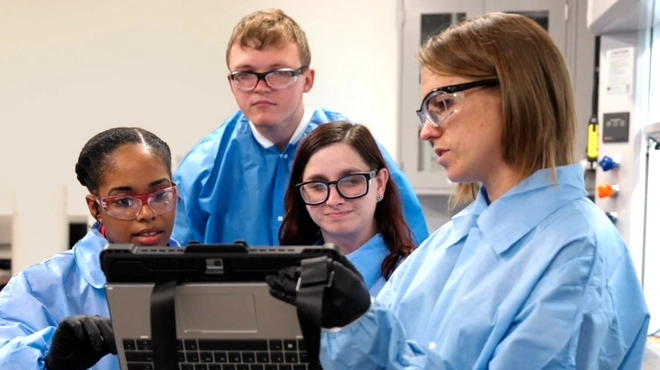Hadcock, an expert in the study of obesity and metabolic diseases, had somehow hit middle age as an overweight smoker. “It was obvious that I wasn’t practicing what I was preaching,” he says.
Over the following two years, from 1997 to 1999, Hadcock ran, going farther and faster. He quit smoking, dropped 40 pounds (18 kilograms), and soon he and Sunny were tackling 15-milers (24 kilometers). These days, Hadcock, a director of Cardiovascular and Metabolic Disease (CMD) at the Novartis Institutes for BioMedical Research (NIBR), runs a marathon each year, usually the Boston Marathon, and when giving it his all, runs a blazing 17-minute 5K.
When you diet, you’re fighting all of that biology ... now I know why people struggle with their body weight.
John Hadcock, director of Cardiovascular and Metabolic Disease (CMD) at the Novartis Institutes for BioMedical Research
Hadcock’s journey back to fitness — and his efforts to stay there — also renewed his commitment to his mission to discover novel drugs to treat obesity. Those efforts have recently paid off with his team’s discovery of a protein secreted by the human intestine that shows promise in early testing in animals. It must still go through a battery of experiments, however, before its safety and efficacy can be tested in people. “Our goal is to find therapies that are safe and exceed 10% weight loss,” says Hadcock. “Based on our preclinical work, we think this one might get us there.”
Only recently has biological science begun to explain how the body regulates weight. If the drug pans out, it could be among the first of a new wave of obesity medications that work, and work well, because they are grounded in science.
Tipping the scales
The need for safe and effective drugs for weight loss has never been more pressing. The obesity epidemic is now global, with approximately 1.4 billion adults overweight and more than one in 10 considered obese, according to the World Health Organization. It affects people of all ages and income levels, all over the world.
“Obesity hides in plain sight,” says Randy Seeley, professor of surgery at the University of Michigan Health System, an obesity expert who collaborates with Hadcock. “Everyone thinks the obesity problem starts with someone heavier than them.”
The real concern is the toll obesity takes on health. Extra weight shortens life expectancy by up to 10 years for severely obese individuals. It also increases the chances that someone will develop type-2 diabetes, heart disease, stroke, and certain forms of cancer.
Despite the risks of obesity, there are few proven treatments. People nonetheless spend billions — $60 billion a year in the United States alone — on weight loss supplements and programs. Most of them, however, have no scientific evidence to support their effectiveness. The few that do, says Seeley, don’t help people lose enough weight and do little to sustain it.
One very effective intervention is gastric bypass surgery. The surgery rearranges the digestive plumbing, bypassing the stomach and part of the highest level of the intestine. According to studies of patients over the long haul, surgery helps them lose an average of 38% of their weight in the first year and maintain a 28% loss 14 years later.
Yet only 1% of the 15 million people eligible for the procedure in the U.S. go through it. The low numbers aren’t surprising. The surgery is expensive (about $25.000 in the U.S.), is not reversible and there aren’t enough trained surgeons to go around. “We need more scalable solutions,” says Seeley.
Couch to super-fit
When Hadcock started running, he was overweight but not obese at 5’ 10” and 190 pounds. His journey from couch to 5K to super-fit competitive runner was relatively easy. He has the competitive edge needed to get out of bed every day and run, even through cold, snowy New England winters. And he has the discipline required to cut calories even after gut-busting workouts. “I never do anything halfway,” he says.
But keeping the weight off for the past 14 years has been an effort. “He’s no fun anymore,” his wife jokes.
Less beer, fewer French fries, and more miles – that’s what it takes. And that is why most people regain the weight they lose from diet and exercise alone. “For me, this experience reinforces the work I’ve been doing for many years,” says Hadcock. “Now I know why people struggle with body weight.”
What Hadcock had known intellectually before and knows in his gut now is that the body actively regulates its weight. When people cut calories, tissues in the intestine, stomach, fat, and muscles send hunger signals to the brain. The body cries out for more food. “When you diet, you’re fighting all of that biology,” says Seeley. “If we don’t change the biological system, it will just drag you back to the same place.”
Years ago, surgeons attributed the success of gastric bypass surgery to its mechanics — a smaller stomach pouch lets in less food. But the mechanics don’t explain the fact that people don’t feel hungry after surgery. The plumbing had changed, but so had the biology. Hadcock decided to find out what had changed and whether those changes might lead to potential new drugs to fight obesity.
Trading scalpels for drugs
Ryan Streeper, a project leader in Hadcock’s group, collaborated with surgeons in the group who performed gastric bypass on obese rats. Some received “sham” surgery and some received a bypass. Several weeks later, after the rats that had received bypass surgery and had lost a substantial amount of weight, the team compared their tissues to those of the control group. The team examined every tissue relevant to metabolism, looking for changes in the activity levels of biological factors.
One jumped to the top. A protein secreted by the middle section of the intestine was seven times higher after bypass. “It was quite striking,” says Hadcock.
The team formulated the protein into drug form and gave it to obese mice. The mice ate less and lost about 30% of their body mass, mostly in the form of fat, results akin to those seen with bypass surgery. The protein hadn’t been recognized as a regulator of appetite before, so Hadcock’s team is making efforts to understand it. “We can try to make this a drug without knowing exactly how it works, but our chances of success go up the more we learn about it,” says Streeper.
While early research results are promising, much work remains to develop a human form of the drug and validate its safety and efficacy. “So far, we’ve passed some of the hurdles,” says Hadcock. “But there are a lot more hurdles to go.”



